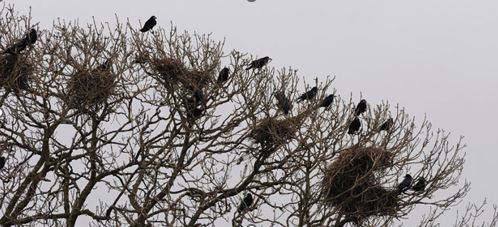Eden Wild Goose Nature
Nature notes from the Focus Magazine April 2022

Rooky musings
I never thought too much about rooks until I was doing my shifts in the cold at the RSPB reserve. There weren’t many callers in in those days, before the visitor centre with wood burner, coffee machine and chocolate flapjacks arrived, so the rooks became a source of entertainment for me with their endless busyness and gregarious chatter among the tree tops, especially at breeding season. I now enjoy watching the rooks who nest in the tall trees, where the mill path reaches Burnrigg Road.
Simon Barnes, the journalist and natural history writer, talks about rooks with a kind of mischievous affection for a bird who, it’s true to say, ranks as one of the less popular. He describes them as resembling craggy tired old undertakers (!), wearing their feathers around the tops of their legs like baggy old trousers, and their grey slatey coloured faces looking like dry bones.
It isn’t always easy to tell rooks from crows but those bald grey faces are a real giveaway, as is the old adage that if you see one rook it’s a crow and if you see two crows they’re rooks. Like all old sayings, it’s not entirely accurate, but nevertheless, rooks are noisy, sociable birds who hang around in flocks and can form roosts of up to thousands, while crows tend to be more solitary.
Rooks like to eat invertebrates and also lots of grain, hence they are traditionally not popular with farmers. It’s thought that scarecrows should really be called ‘scarerooks’, because mobs of rooks are more focused on the rich pickings in open arable fields while crows are happy with almost anything. Boys were employed as bird scarers by landowners at critical points in the farming year, up to the early years of the twentieth century, a role which was considered very lowly and lonely.
A quick search of Google didn’t reveal many thoughtful rook related poems- the birds don’t appear to function as an artistic muse particularly. However, John Clare, the poet, who so faithfully recorded his rural life in Northamptonshire in the nineteenth century, does write of,
The mingled, swarthy cloud-
rook, crow and jackdaw- noising loud ,
Fly to and fro to dreary fen….’
And, indeed, the different birds do often form one large flock, especially the rooks and jackdaws.
And just in case you’re still unconvinced there is anything much of interest about rooks, they also apparently made decent pies for rural folk back in the past and at least a couple of English pubs have made quite a thing of their annual rook pie nights up to the last few years at least.
Like their relatives, crows and jackdaws, rooks are extremely intelligent birds and have been known to form affectionate relationships with humans though presumably before they were put into pies.
So, maybe there is plenty to note and enjoy about the common or garden rook, not so pretty, not so favoured with poems and pictures, but still a part of the whole and a familiar part of our landscape.
Philippa Skinner